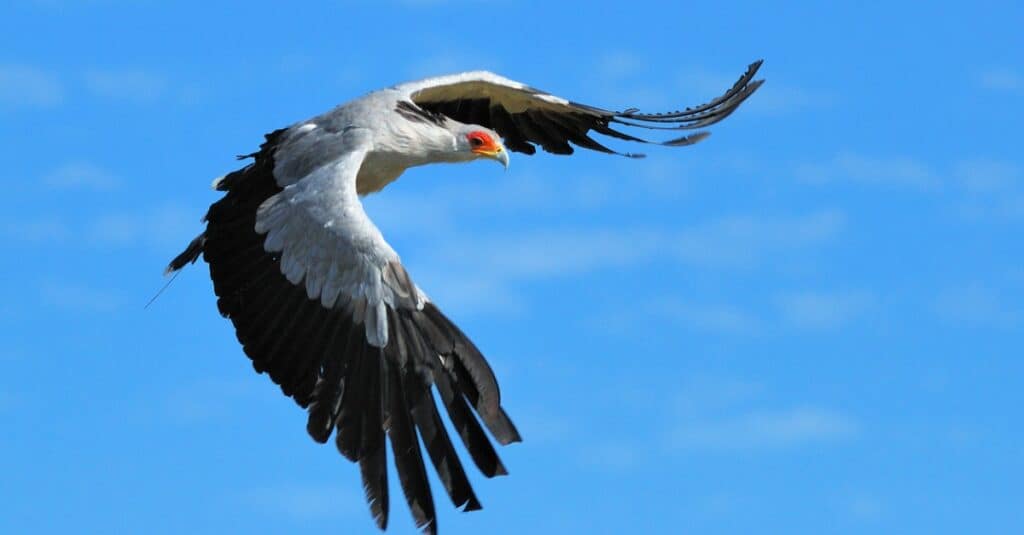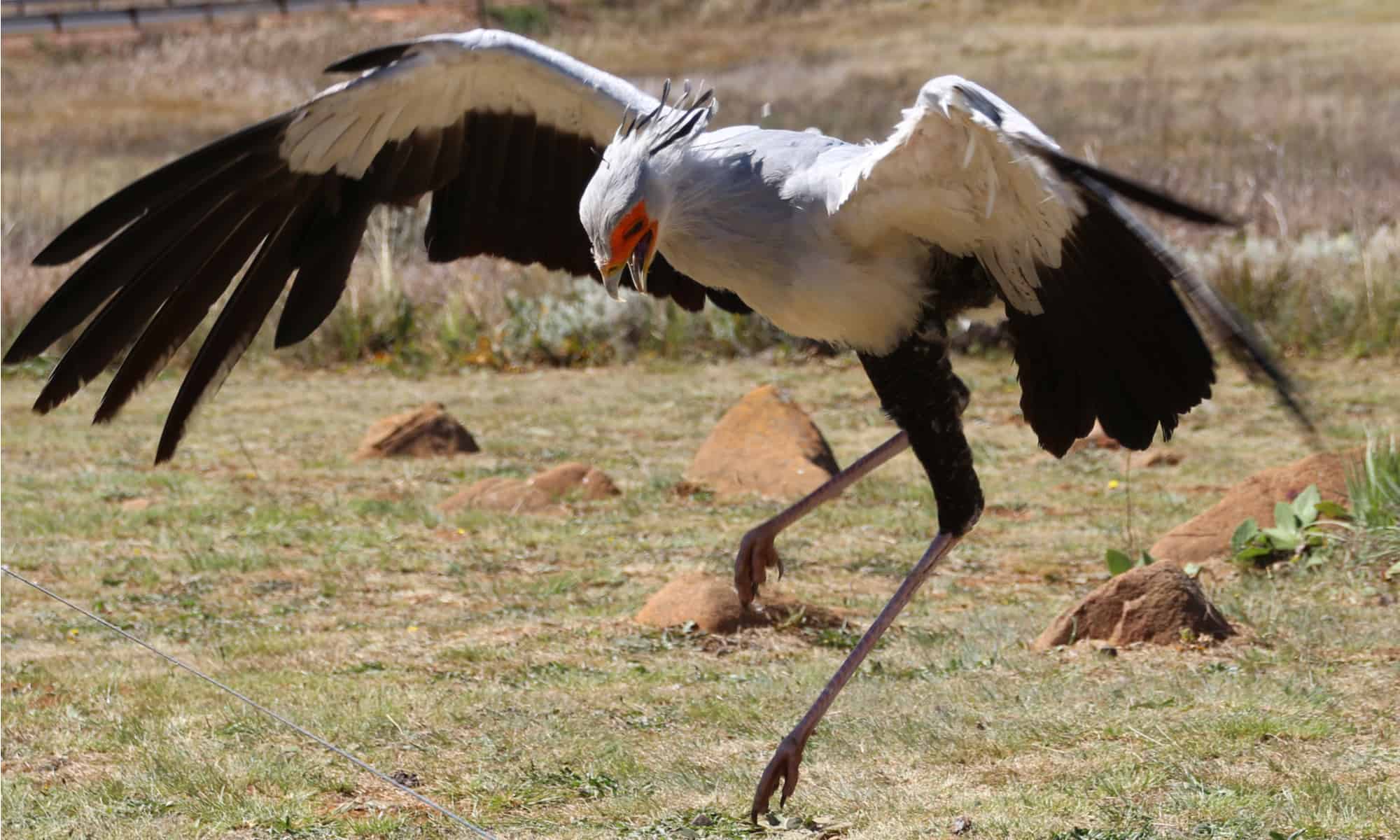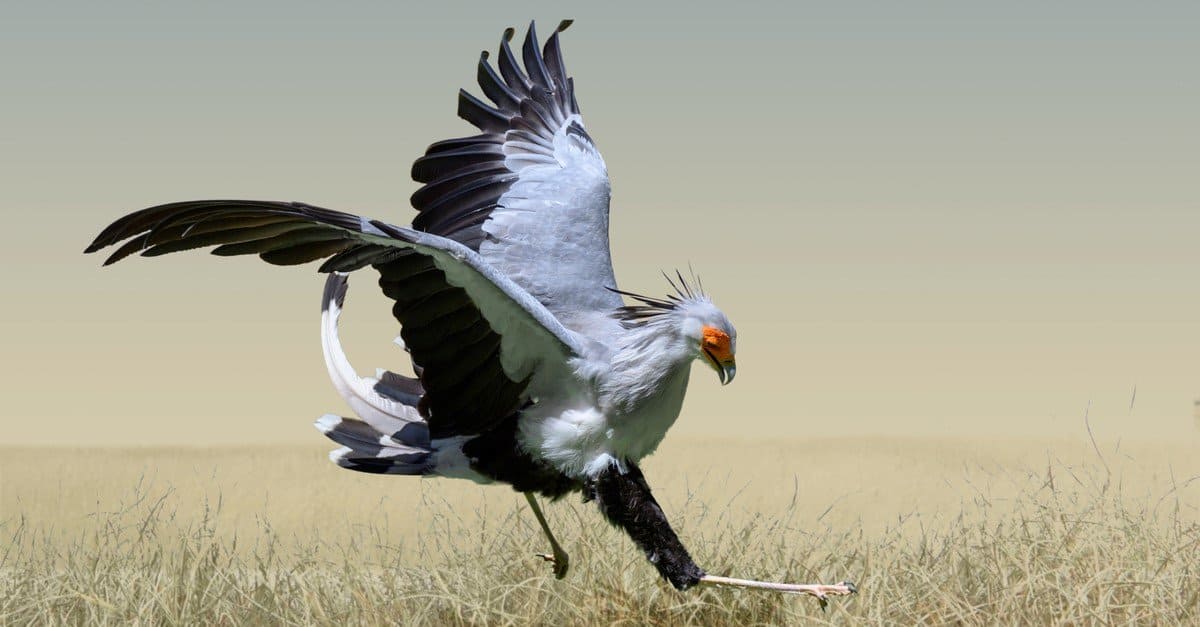This long-legged bird of prey packs a powerful punch. Where most of its raptor relatives use flight as a way to capture snakes, the secretary bird stalks the grassy landscape of Sub-Saharan Africa to snare snakes. The power and speed behind their legs are unbelievable. So, let’s meet the secretary bird and learn about its snake-hunting abilities.
Introduction: Introducing the Secretary Bird – A Towering Predator Specialized in Hunting Snakes

Their taxonomic name,
Sagittarius serpentarius, translates to “the archer of snakes.”
©Cathy Withers-Clarke/Shutterstock.com
It is traditionally thought that the name “secretary bird” came from Europeans in the early 19th century. In Europe at the time, the male secretaries wore gray tailcoats paired with knee-length pants. Using quill pens to jot notes or dictations, a secretary would often stash the quill behind his ear until the quill was needed again. In the same manner, the secretary bird has dark feathers at the back of the head, not to mention long, gray wings and tail feathers. Combining that with its black feathers that go halfway down its legs, it looks like the secretary bird is wearing knee-length pants and a tailcoat.
This snake-eating predator is native to Sub-Saharan Africa and dwells in the grasslands. Distantly related to buzzards, vultures, and kites, the secretary bird is the largest terrestrial (hunting for food on foot) predatory bird. Although they spend most of their time hunting on the ground, the secretary bird is a good flier. They build their nests high in acacia trees, where they roost for the night as well as lay their eggs after the breeding season.
Breeding and Lifespan: Discovering the Life Cycle of the Secretary Bird

The secretary bird is monogamous, and the pair will build a nest toward the top of a dense, thorny tree to protect their chicks and stay safe while roosting.
©iStock.com/Shumba138
Secretary birds mate with a single partner for life. Together, the pair will defend a territory of about 20 square miles for hunting. They are able to mate throughout the year, but the peak breeding season is between August and March. Most mate on the ground, but they may also mate in trees.
The pair then builds a nest toward the top of a dense, thorny tree for protection, such as an acacia tree. They construct the nest from sticks, and the nest may be anywhere from three to five feet wide and up to twenty inches deep. In the middle, a depression is made and lined with soft grass for the eggs.
Typically one to three eggs are laid, which are incubated by both the female and male. It takes about six to seven weeks to incubate the eggs, and once the chicks hatch, both parents are in charge of feeding them. They do this by regurgitating food for the young. And at least one of the birds stays with the nest to protect the chicks from predators for the first three weeks. Hungry crows, owls, and hornbills will take any opportunity to prey on the chicks.
If the environment is good, all of the chicks will survive. But, if conditions are dry and food is scarce, it is likely one or more of the chicks will die of starvation.
Secretary birds have a lifespan on average of 10-15 years. However, some that live in zoos have been known to live past 19 years old.
Unique Physical Characteristics: Exploring the Impressive Height and Specialized Adaptations of the Secretary Bird

They have the longest legs of any bird of prey.
©Karel Bartik/Shutterstock.com
On average, a secretary bird’s height is 4.1 to 4.9 feet, with a wingspan of 6.9 feet. Typically, they weigh anywhere from 5 to 9.4 pounds. Compare that to a buzzard which is only one to three pounds in size!
The secretary bird has the longest legs of any bird of prey. Its long, powerful legs keep it above the vegetation, giving it a better vantage point when hunting. Thick scales cover the lower two-thirds of its legs to protect the secretary bird from snake bites.
The secretary bird’s taxonomic name, Sagittarius serpentarius, translates to “the archer of snakes.” And it certainly lives up to the name. They use their powerful legs to deliver lethal kicks to a snake’s head. They can put five times their weight behind a kick while only taking 0.015 seconds to strike. This kick is about 100 times faster than a snake can bite, leaving the secretary bird the unequivocal winner.
Hunting Techniques and Diet: Understanding the Fascinating Hunting Behaviors and Snake-focused Diet

As these birds catch their prey, they may flap their wings to serve as a distraction for the snake or as a target.
©Mike van Kal/Shutterstock.com
Secretary birds leave their roost to go hunting a few hours after dawn. During the hottest point in the day, they will take cover under shady trees before going out to hunt again. These birds can cover 20 miles in a day of hunting. Just before sunset, they return to their roost for the night.
While snakes make up the bulk of the secretary bird’s food, they also supplement their diet with lizards, grasshoppers, mice, and eggs of other bird species. Many times, the secretary bird hunts in pairs or in small groups to better sweep the area. When they discover a snake, they will stamp or flail it against the ground until the snake is dead. Other times, they may even drop the snake from high up.
As secretary birds catch their prey, they may flap their wings to serve as a distraction for the snake or as a target. The movement of the wings draws the snake to strike, but a venomous bite to hollow feathers won’t hurt the secretary bird. This tactic keeps its legs and body from harm.
Habitat and Distribution: Unveiling the Range and Preferred Habitats of the Secretary Bird
One may find secretary birds south of the Sahara Desert and from Senegal to Somalia above the desert. They prefer savannas, grasslands with small thorn trees, and open areas around forests and woodlands. Secretary birds have even been seen hunting around airfields and wide pastures.
Generally, observing the secretary bird in a hilly or mountainous area is rare. They avoid dry regions and keep to spaces where snakes are plentiful and trees are available for nesting.
Conservation and Threats: Examining the Conservation Status and Efforts to Protect this Iconic Raptor Bird

Scientists in the UK have found that the Secretary Bird, native to sub-Saharan Africa, can deliver precise and powerful kicks with a force five times its own body weight, enough to kill venomous snakes in less than the blink of an eye.
©Barbara Ash/Shutterstock.com
Because secretary birds are so good at killing snakes, they are protected in most African countries. However, their numbers keep dwindling from habitat degradation and human disturbance.
Over-grazed grasslands leave little cover for snakes and other prey, and the secretary bird will follow where the food goes. Urban development and even farming erase the habitats the secretary bird needs to survive.
Currently, habitat conservation efforts have been deployed, including protecting areas like the Kruger National Park and other protected lands for the secretary bird to find sanctuary. Various organizations are also working to find an updated number on the birds’ population. Education and awareness efforts for locals, hunters, and farmers have been a focus, as well as monitoring the trade of the birds.
All in all, this extremely talented snake hunter is finding more and more protection across Africa. It is an admired bird for its stunning appearance and for keeping snake populations in check. It is on the coat of arms for South Africa and on the emblem of Sudan. The secretary bird has been used as a symbol of protection, and many efforts have been implemented to keep this unique bird safe.
The photo featured at the top of this post is © Karel Bartik/Shutterstock.com
Thank you for reading! Have some feedback for us? Contact the AZ Animals editorial team.






